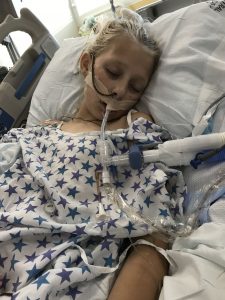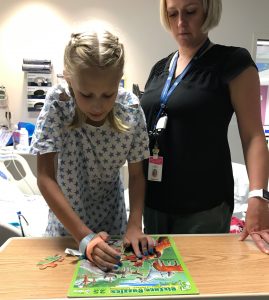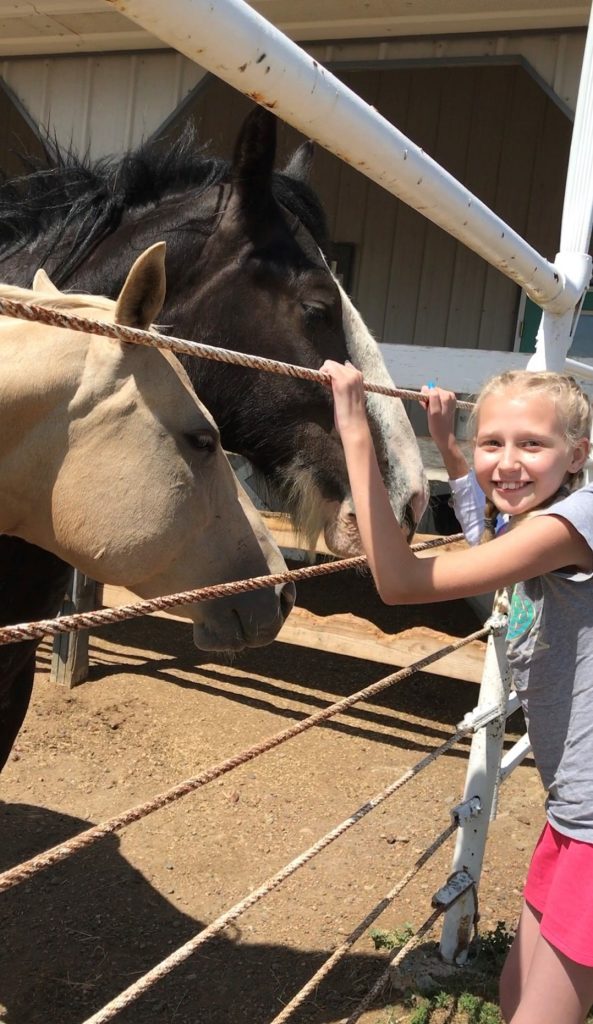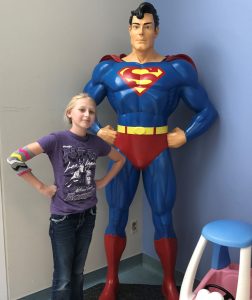Sepsis can and does affect people of all ages…even spunky 10-year-olds
According to the National Sepsis Alliance, sepsis affects over 26 million people worldwide each year and is the largest killer of children in the world. Britney Geving and Derek Lyson know first-hand the devastating effects of sepsis. They nearly lost their daughter Kennedy to sepsis in 2017 following a horse-riding accident which led to multiple surgeries and hospital stays….not to mention, the many days of worrying watching their daughter’s health decline and feeling helpless.
“I knew something was really wrong, but I was at a loss as to what to do,” states Britney. After 3 weeks of not seeing any improvement, a desperate Britney asked to have her daughter transferred. She told hospital staff, “It’s time to send us somewhere else.”
Read the account of Kennedy’s sepsis journey and her remarkable strength to overcome the effects of an illness that nearly claimed her life.
~~~~
On a beautiful day in June of 2017, 10-year-old Kennedy Lyson was riding her new horse around the yard. For an unknown reason, the horse reared straight up with her still in the saddle and came over backwards on Kennedy’s belly. The horse fell with such force that the stitching from the saddle horn imprinted into the tissue surrounding her belly button.
While Kennedy did not show signs of a head injury or broken bones, she was taken by ground ambulance to Baker, MT, where an abdominal CT scan showed she suffered abdominal injuries. Kennedy’s mother, Britney, was told “there are lots of internal fluids where there shouldn’t be” and the recommendation was made to send her to a larger facility. Kennedy was airlifted to Billings, MT, where she underwent abdominal surgery which revealed a tear in the mesentery lining of the small intestine. Following surgery, Kennedy’s parents were told that normally the damaged part of the bowel would have been removed, but the surgeon thought it had enough blood supply so the bowel was reattached.
 Kennedy had a somewhat complicated hospital stay for the next 8 days, with continued severe pain, a fever of 104+ and vomiting. The discharge plan was that as soon as she could eat a full meal and have no fever for 24 hours, she could go home. After three days of not being able to eat, her NG (nasogastric) tube, which she still had from surgery, was used as a feeding tube. She received a nutritional supplement, via the NG tube. She started gaining some strength and was able to go home.
Kennedy had a somewhat complicated hospital stay for the next 8 days, with continued severe pain, a fever of 104+ and vomiting. The discharge plan was that as soon as she could eat a full meal and have no fever for 24 hours, she could go home. After three days of not being able to eat, her NG (nasogastric) tube, which she still had from surgery, was used as a feeding tube. She received a nutritional supplement, via the NG tube. She started gaining some strength and was able to go home.
Over the next couple of weeks, Kennedy was not improving. She didn’t have an appetite, was fatigued, lost weight and had diarrhea. The family attributed it to just having had major surgery, but they also took her to several local clinics to be examined. At one visit, Kennedy was deemed dehydrated and was admitted to the hospital to receive IV fluids and observe her overnight. This overnight stay turned into a week after a bowel blockage was discovered. Britney felt they were simply waiting for Kennedy to have a bowel movement to indicate the bowel was working and that she could do that at home. They were finally allowed to go home.
Within a half hour of being home, Kennedy was resting on the couch when she suddenly stood up and clutched her lower abdomen and screamed, “It hurts so bad!” Britney immediately called the Miles City Clinic to report Kennedy’s symptoms and was told it was probably a bladder infection and to encourage her to drink fluids and go to the bathroom. That same day, Britney took Kennedy back to the clinic in Baker where a bladder infection was ruled out. Britney reports “really feeling at a loss.” She felt something was “really wrong”, but didn’t want to be the hypochondriac mother. They spent the day at Baker where it was finally decided that Kennedy needed to go back to Billings via ground ambulance.
In Billings, the doctors were hesitant to do more testing because she had already received a fair amount of radiation so they made the decision to observe her for the night. The surgeon also was not in favor of doing another surgery because she just had surgery three weeks prior. Over the next 36 hours, Kennedy’s condition failed. Derek, Kennedy’s dad who lives in Marmarth, ND, remembers, “she was green and lethargic.” She ran a 105° fever most of the night with nightmares from the fever and/or medications. In her nightmares, she would hallucinate, frantically urging her mom, “Hurry, we have to get up!”
The next morning, Britney knew she had to do something; she was alarmed that Kennedy was not getting better. She showered and packed her bag and met the doctor in the hall and said, “It is time to send us somewhere else.” They discussed options for treatment and the doctor expressed concern that Kennedy was developing sepsis. She was transferred to Primary Children’s Hospital in Salt Lake City. Arrangements were made and the flight team was in Kennedy’s room in 20 minutes. It was a very emotional time to see their daughter once again being strapped into a gurney.
In Salt Lake City, the family was escorted by security to a prepared hospital room and the doctor met them almost immediately stating that another CT scan was needed as there was something clearly wrong with Kennedy. The initial treatment plan was to get the CT and observe her overnight. However, once the CT was performed, the surgeon told Britney and Derek that Kennedy needed surgery immediately to remove damaged bowel; although the decision was ultimately up to them. They had touched down in Salt Lake City at noon and by 1:30 p.m., Kennedy was taken to surgery. Following surgery, when she was getting settled in her room, one of the nurses said to Britney, “I am so glad you came when you did. She wouldn’t have made it much longer!” It was July 3.
Kennedy’s family was told to plan to stay for at least a week as this was very serious and it would take time to heal. The family felt that staff was sheltering them. They could hear the staff discussing sepsis, but that exact term was hardly said directly to them. The illness was taking its toll on Kennedy. It was getting harder on her each time a new IV was needed, so a Peripherally Inserted Central Catheter (PICC) line was inserted. On July 6, she was started on Total Parenteral Nutrition (TPN) to receive nutrition intravenously so she could completely rest her stomach.
Britney remembers there seemed to be a “24-hour” watch where medical staff would try a big intervention and expect to see an improvement within 24 hours. On July 9, an ultrasound was done and a very large abscess was found in her abdomen. Another “small” procedure was needed to drain this. This procedure did not yield the expected response. Up to this point, her abdominal incision had been “left open” to a certain degree to allow for drainage and healing from the inside out.
At some point in the next couple of days, one of the family’s favorite nurses came back on shift, took one look at Kennedy and felt there was a major decline since the last time he saw her. He notified the physician and after examination, it was decided they needed to surgically open her abdomen once again. Once opened, they discovered over 100 abscesses throughout her abdomen. This resulted in a plan to do a series of “washouts” every couple of days to clean out the abscesses. These started on July 11 and were planned every 2 days until clear. Kennedy returned to PICU on a ventilator in a medically-induced coma. Britany stated, “Kennedy was so strong, she kept breathing over the vent causing respiratory therapists to have to adjust the vent settings.”
Kennedy slept through much of this, despite many conversations happening in her room. One night, Britney and a nurse were discussing Britney’s birthday, which was the next day. On the morning of July 13, even after sleeping so heavily, Kennedy woke up at 7:30 a.m., grabbed her dry erase board and wrote “Happy birthday, Mom! I love you!”
 After the second washout, hospital staff started to see progress. They already couldn’t find any more infection. Kennedy had an incident around this time in which her NG tube became kinked. Kennedy remembers waking up and “freaking out” because she felt like she couldn’t breathe and/or was going to throw up. She frantically hit her call-light to get someone’s attention. She says her mom taught her sign language when she was little, and she was trying to sign to her mom that she couldn’t breathe. Britney saw Kennedy leaning over the bed rail and signing she couldn’t breathe. Britney stated, “It was confusing to staff because she remained on the ventilator and she shouldn’t have been feeling that way because the vent was breathing for her. However, once bile started coming out of her mouth, the staff certainly hustled to find the cause which was a kinked NG tube.”
After the second washout, hospital staff started to see progress. They already couldn’t find any more infection. Kennedy had an incident around this time in which her NG tube became kinked. Kennedy remembers waking up and “freaking out” because she felt like she couldn’t breathe and/or was going to throw up. She frantically hit her call-light to get someone’s attention. She says her mom taught her sign language when she was little, and she was trying to sign to her mom that she couldn’t breathe. Britney saw Kennedy leaning over the bed rail and signing she couldn’t breathe. Britney stated, “It was confusing to staff because she remained on the ventilator and she shouldn’t have been feeling that way because the vent was breathing for her. However, once bile started coming out of her mouth, the staff certainly hustled to find the cause which was a kinked NG tube.”
 On July 14, the process for weaning Kennedy off the vent started and she was able to go for the last surgery without a vent on July 15. She was discharged out of PICU on July 17 with the hope that she could possibly go home in another couple of days. She had lost so much strength and muscle, she wasn’t able to walk. When her accident happened, she weighed about 100 pounds and had lost 25% of her body weight and now weighed about 73 pounds. Kennedy was physically, emotionally and spiritually drained. Britney shared, “Even though all of her numbers were getting back to normal, Kennedy couldn’t eat or walk and just wanted to sleep. She had given up hope and didn’t care.” TPN continued throughout all this time, and adjustments were constantly being made to her calorie intake to try to stimulate an appetite. Very, very slowly she was able to eat. With the assistance of physical therapy, she slowly was able to go for walks and regain some strength.
On July 14, the process for weaning Kennedy off the vent started and she was able to go for the last surgery without a vent on July 15. She was discharged out of PICU on July 17 with the hope that she could possibly go home in another couple of days. She had lost so much strength and muscle, she wasn’t able to walk. When her accident happened, she weighed about 100 pounds and had lost 25% of her body weight and now weighed about 73 pounds. Kennedy was physically, emotionally and spiritually drained. Britney shared, “Even though all of her numbers were getting back to normal, Kennedy couldn’t eat or walk and just wanted to sleep. She had given up hope and didn’t care.” TPN continued throughout all this time, and adjustments were constantly being made to her calorie intake to try to stimulate an appetite. Very, very slowly she was able to eat. With the assistance of physical therapy, she slowly was able to go for walks and regain some strength.
In late July, Britney started asking what it would take for Kennedy to be able to go home. Britney felt it would be good for Kennedy to be in her own home, to see her brother and her sister, and sleep in her own bed. They had been in Salt Lake City for 26 days and almost two whole weeks had passed without having any other family or friends for support.

Kennedy seeing her horses for the first time after returning home.
After much discussion, Britney and Derek agreed to take a class on how to manage the PICC line so Kennedy could continue to receive TPN at home. Kennedy, Britney and Derek flew home on July 28. Initially Kennedy had to be taken to Baker once a week for wound cares, but Britney eventually assumed care of this as well. The first day she got out of the house, Kennedy asked to see her horses. When they got to the fence, her three favorite horses came walking to her with their ears pricked up at attention, sniffing and nuzzling Kennedy. Sampson, a Shire gelding who is a very large animal but “wanna-be lapdog” came up to Kennedy and seemed to sense that something was wrong. Sampson was a bit tentative at first, but once Kennedy started playing with him and squeezed his nose, he returned the affection and started nibbling on her.
That fall, Kennedy went back to school—part time initially. They tried to time her TPN to run overnight, but a few times she had to wear it to school in a backpack. On October 2, Kennedy was completely done with TPN and the PICC line was removed.
 The family reports not receiving any further education about sepsis during the hospital stay. When asked what message the family would like to convey about this experience and sepsis, Britney stated “Healthcare providers should listen to the parent. A mother knows her child best and would not put their child through something that is not needed. Please listen to the mother and family!” Britney also urged doctors to be willing to admit when they don’t have experience with a given situation and when they may need help finding answers to their questions. Through all of this, Britney has learned that children are not just “miniature adults” and sometimes need specialized care.
The family reports not receiving any further education about sepsis during the hospital stay. When asked what message the family would like to convey about this experience and sepsis, Britney stated “Healthcare providers should listen to the parent. A mother knows her child best and would not put their child through something that is not needed. Please listen to the mother and family!” Britney also urged doctors to be willing to admit when they don’t have experience with a given situation and when they may need help finding answers to their questions. Through all of this, Britney has learned that children are not just “miniature adults” and sometimes need specialized care.
Sepsis-survivors can often experience Post Sepsis Syndrome with fatigue, memory loss, mood issues or physical issues. Kennedy is currently doing well, without these symptoms. She does have some problems with a “touchy bowel” and is more cautious than before. Kennedy says, “I have to be careful sometimes with certain movements.” Britney reports that Kennedy has grown up quickly and is a stronger person. She gushes, “Kennedy is a phenomenal young lady. I hope you get to meet her someday!”
Sepsis is the body’s overwhelming and life-threatening response to infection that can lead to tissue damage, organ failure and death. It is a treatable condition but yet kills more than 258,000 people in our country every year. The chance of survival from sepsis drops 8% every hour it is not treated. In the Great Plains QIN region, sepsis is the leading cause for admissions and readmissions to the hospital for Medicare beneficiaries. Great Plains QIN is working with EMS professionals, healthcare providers, and consumers in our region to improve early recognition and raise awareness of sepsis as a medical emergency. You can save a life just by knowing the signs of sepsis. It’s about time:


